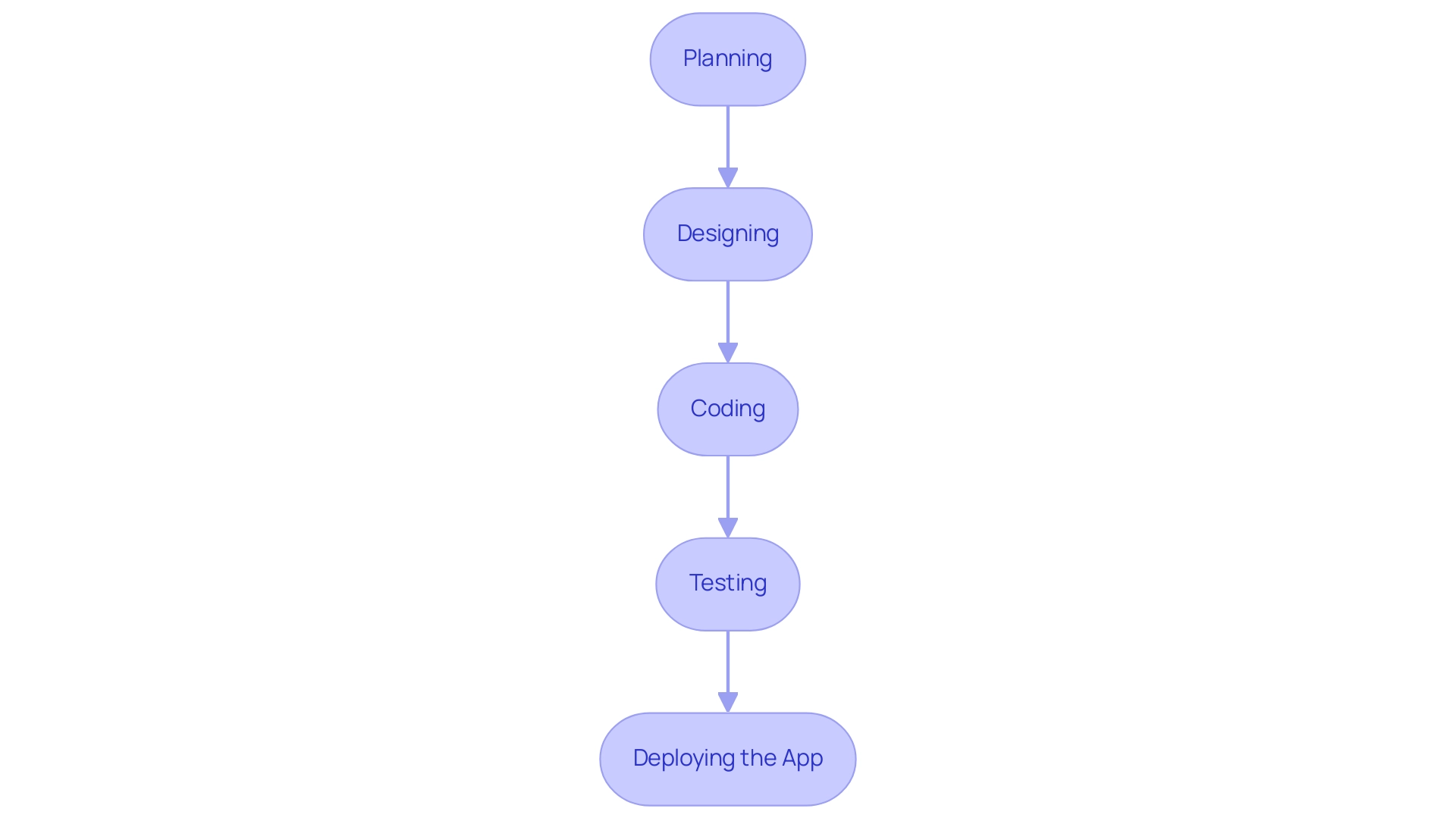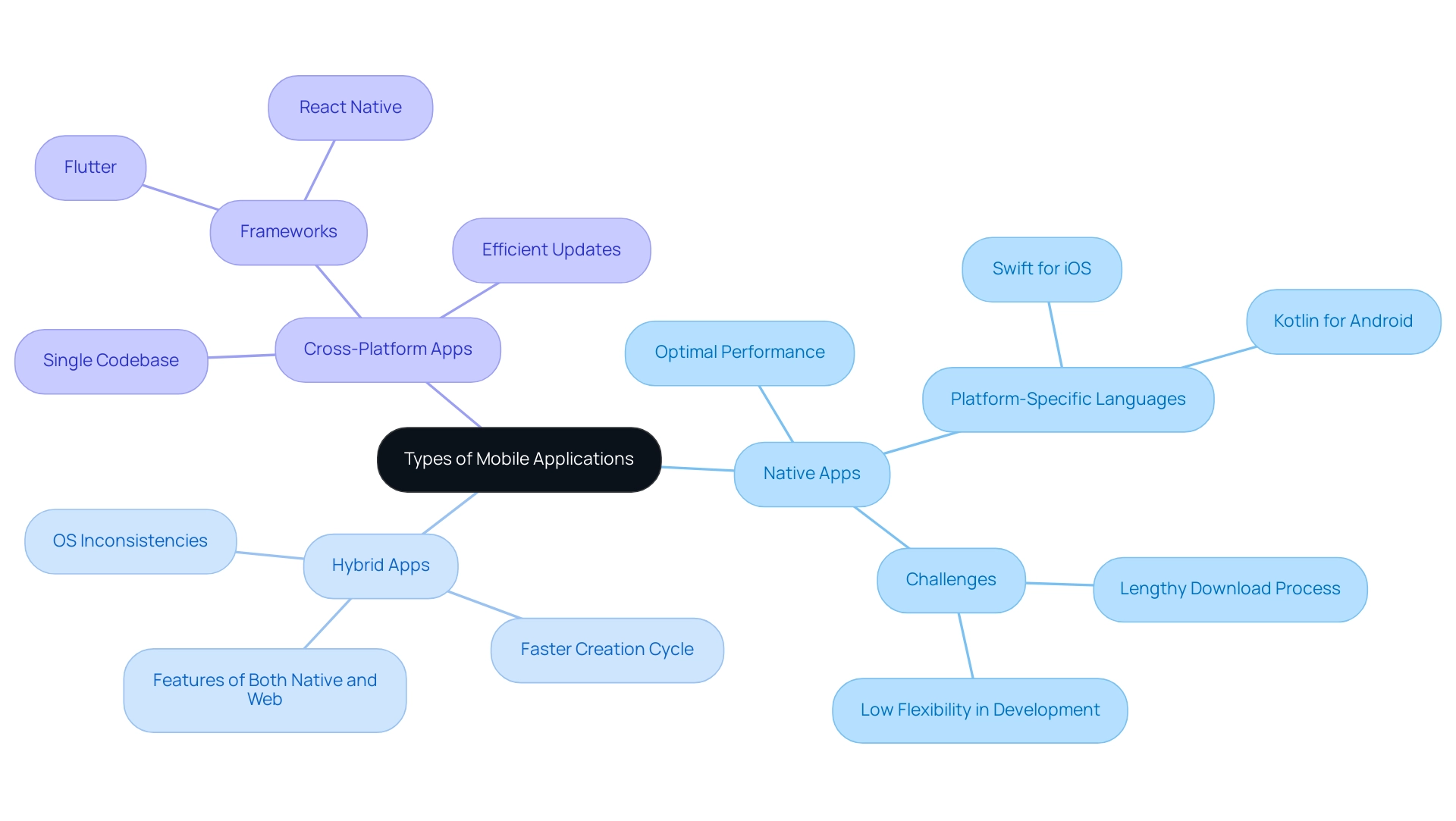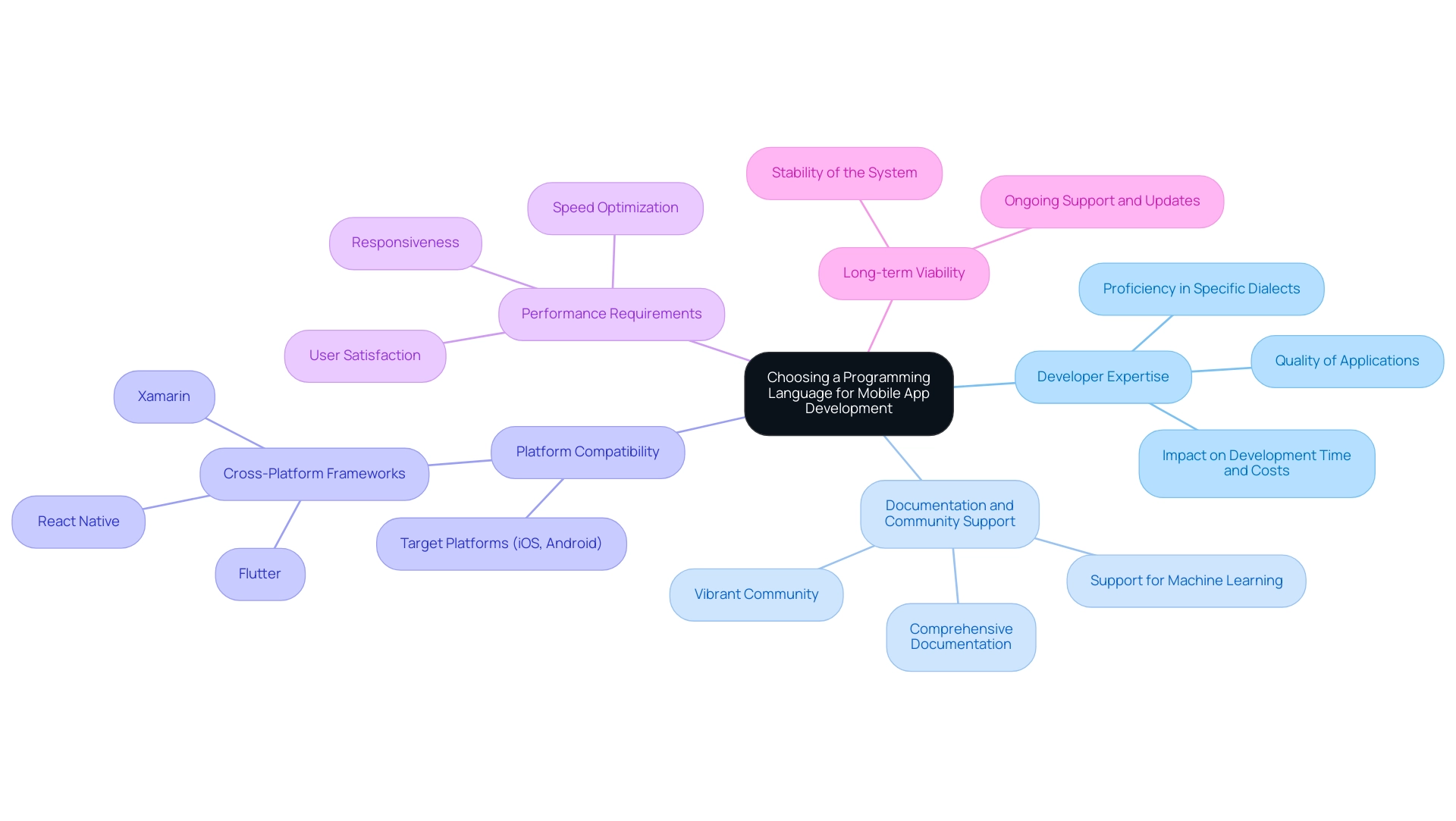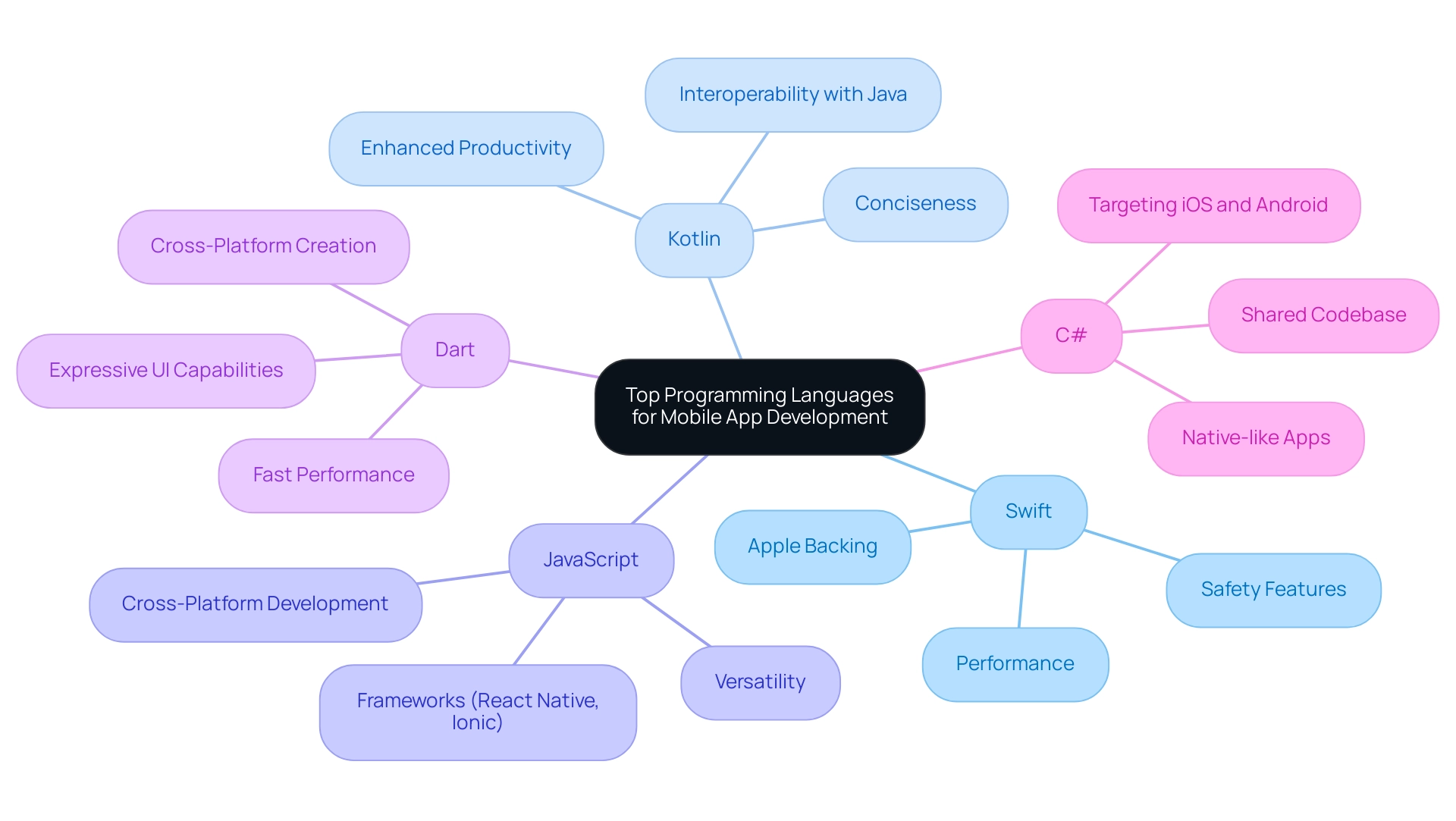Introduction
In the dynamic realm of mobile app development, understanding the intricacies of creating applications for smartphones and tablets is essential for developers aiming to thrive in a competitive market. With users dedicating a significant portion of their day to mobile applications, the stakes have never been higher for developers to deliver seamless, high-performance experiences.
This article delves into the multifaceted world of mobile app development, exploring the various types of applications—native, hybrid, and cross-platform—while emphasizing the critical considerations for selecting the right programming language.
By examining key factors such as:
- developer expertise
- platform compatibility
- long-term viability
developers can make informed decisions that align with both user expectations and technological advancements. As the mobile landscape continues to evolve, staying abreast of current trends and best practices will be paramount for success in this ever-changing field.
Understanding Mobile App Development
Mobile app creation encompasses the establishment of software applications designed to operate on mobile devices, including smartphones and tablets. The development lifecycle typically involves stages such as:
- Planning
- Designing
- Coding
- Testing
- Deploying the app
A critical aspect of this process is a thorough understanding of the mobile app ecosystem, which includes user expectations and the inherent capabilities of various devices.
According to global surveys, users dedicate approximately four hours daily to their mobile devices, with over 75% of that time spent engaging with applications. This statistic highlights the necessity for programmers to prioritize:
- Performance
- User experience
- Compatibility across different operating systems
All of which can be significantly impacted by the choice of programming language. Staying abreast of the latest advancements, such as the rise of digital wallets for real-time cross-border payments and enhanced mobile banking security, is paramount in meeting evolving user expectations.
As noted, digital wallets are becoming a standard for everyday commerce, highlighting the need for creators to remain informed about current trends. Furthermore, with the introduction of foldable smartphones, there is a unique opportunity for app developers to create tailored applications optimized for these devices, as evidenced by the case study on customized apps for foldable devices. A solid understanding of mobile application creation principles enables you to make strategic choices concerning selection suited to your project's unique requirements.
As the landscape continues to evolve, being adaptable and informed will be crucial for success in mobile app development.

Types of Mobile Applications: Native, Hybrid, and Cross-Platform
Mobile applications can be developed using a mobile apps programming language, which allows categorization into three primary types: native, hybrid, and cross-platform. Native apps are designed specifically for a single platform, such as iOS or Android, utilizing platform-specific programming languages like Swift or Kotlin. This approach ensures optimal performance and a seamless user experience, allowing developers to leverage the full capabilities of the device.
However, native apps can present challenges, such as lengthy download processes and restricted adaptability in creation, which may deter users from downloading them. For instance, the case study titled 'Challenges of Native Apps' highlights how these factors complicate the user experience and creation process, requiring separate coding for different platforms.
Hybrid apps, on the other hand, amalgamate features of both native and web applications. By utilizing technologies such as HTML5, CSS, and JavaScript, hybrid applications provide a faster creation cycle and the capability to launch across multiple platforms. While this method permits a broader reach, it may result in OS inconsistencies, as certain features might not operate uniformly across various operating systems.
Cross-platform applications, created using frameworks such as Flutter or React Native, enable programmers to maintain a single codebase for multiple platforms, balancing performance with efficiency. React Native has gained particular acclaim for its synergy with web design, fast iteration cycles, and the ability to implement updates without the need for app store reviews. Grasping these distinctions is crucial for choosing the suitable mobile apps programming language and frameworks tailored to your specific project needs, as the decision can greatly affect both user engagement and the overall success of the application.
As mobile app statistics show, health and fitness apps typically have an ARPU of approximately $30 to $50 each year, highlighting the potential revenue consequences of app creation. Therefore, it’s important to take your time and research the mobile app statistics first to learn about future growth.

Key Considerations for Choosing a Programming Language
When choosing a programming tool for mobile app creation, several critical factors warrant careful consideration:
-
Developer Expertise: The proficiency and experience of your programming team are paramount. A group proficient in particular dialects can significantly streamline the development process, reducing both time and costs. Expertise not only enhances efficiency but also leads to higher-quality applications.
-
Documentation and Community Support: Opt for programming options that boast comprehensive documentation and a vibrant community. Such resources facilitate troubleshooting and problem-solving, enabling developers to overcome challenges swiftly. As an unknown expert wisely noted,
With the help of this technology, our interactions with the digital world will be redefined and become more natural and user-friendly.
This highlights the importance of supportive resources in creating intuitive user experiences. Furthermore, with the projected doubling of firms investing in machine learning over the next three years, selecting a medium that supports such advancements is increasingly relevant. -
Platform Compatibility: Ensure that the chosen language aligns with the platforms you aim to target, whether that be iOS, Android, or both. The rise of cross-platform frameworks like Flutter, React Native, and Xamarin exemplifies the trend toward utilizing a mobile apps programming language to create apps that function seamlessly across multiple operating systems. This trend not only simplifies the development process but also broadens the potential user base, making it crucial to consider when selecting a mobile apps programming language.
-
Performance Requirements: The performance capabilities of a system are crucial, particularly for resource-intensive applications. A system that optimizes speed and responsiveness is vital for user satisfaction and overall app success.
-
Long-term Viability: Assess the longevity and ongoing support of the programming system. In a rapidly evolving technological landscape, a stable system that receives regular updates can ensure that your application remains relevant and maintainable well into the future.
By highlighting these factors, along with the case study of Voice & ChatBot Assistance, where the integration of programming systems significantly enhances user-centric design and functionality, developers can make informed decisions that align with both their technical capabilities and the demands of modern mobile app users.

Top Programming Languages for Mobile App Development
When it involves mobile app creation, choosing the appropriate mobile apps programming language is essential. Below are some of the leading options in 2024:
-
Swift: As the main tool for iOS creation, Swift boasts performance and safety features that are essential for creating robust applications.
Its modern syntax, combined with Apple's backing, positions it as the go-to choice for native iOS apps. The advantages of Swift are further highlighted by its ability to deliver seamless user experiences and high performance. -
Kotlin: This has emerged as the preferred choice for Android development.
Known for its conciseness and expressiveness, it enhances programmer productivity while reducing boilerplate code. Kotlin's interoperability with Java allows teams to leverage existing Java codebases, making it a strategic choice for many projects. -
JavaScript: This versatile language is widely used for hybrid and cross-platform applications.
With frameworks such as React Native and Ionic, creators can accomplish swift creation and deployment, fulfilling the increasing need for adaptable applications across multiple platforms. -
Dart: Gaining momentum through its association with the Flutter framework, Dart is recognized for its fast performance and expressive UI capabilities.
It enables cross-platform creation, making it a favored choice among creators seeking to build visually attractive applications efficiently. -
C#: Utilized in Xamarin for cross-platform creation, C# enables the production of native-like apps with a shared codebase.
Its versatility enables creators to target both iOS and Android platforms, which can simplify the creation process.
Each mobile apps programming language provides distinct benefits suited to particular project needs and team skills. As Lena Charles aptly notes,
To make the right choice, you need to understand your development needs and the type of application you are looking to develop.
Given that the app market's global revenue is projected to increase at a CAGR of 8.83% from 2022 to 2027, making a well-informed choice today can have substantial effects on future success.
At Simublade, our team of skilled professionals is proficient in multiple languages and technologies, ensuring that you have the right expertise for your project. When examining the hiring process, clients can communicate their requirements, and a business consultant will reach out to them within 24 hours to discuss project details and assign an appropriate professional. This streamlined approach is crucial, especially when considering the findings from a recent case study where 61% of developers reported spending over 30 minutes daily searching for solutions.
This highlights the importance of having efficient resources and support throughout the development process.

Conclusion
In the ever-evolving landscape of mobile app development, understanding the nuances of creating high-quality applications is essential for developers aiming to succeed. By exploring the various types of applications—native, hybrid, and cross-platform—developers can make informed choices that cater to user needs and technological trends. The significance of selecting the right programming language cannot be overstated, as it directly impacts performance, user experience, and long-term viability.
Key considerations include:
- Developer expertise
- Platform compatibility
- Community support
These factors play a critical role in ensuring a smooth development process. Each programming language, from Swift and Kotlin to JavaScript and Dart, offers unique advantages that can align with specific project requirements. By leveraging the strengths of these languages and frameworks, developers can create applications that not only meet current demands but also anticipate future trends.
As the mobile app market continues to grow, it is imperative for developers to stay abreast of technological advancements and user expectations. This proactive approach will not only enhance the quality of applications but also position developers to capitalize on emerging opportunities. Embracing the complexities of mobile app development with a strategic mindset will ultimately lead to delivering exceptional user experiences and achieving lasting success in this competitive field.





